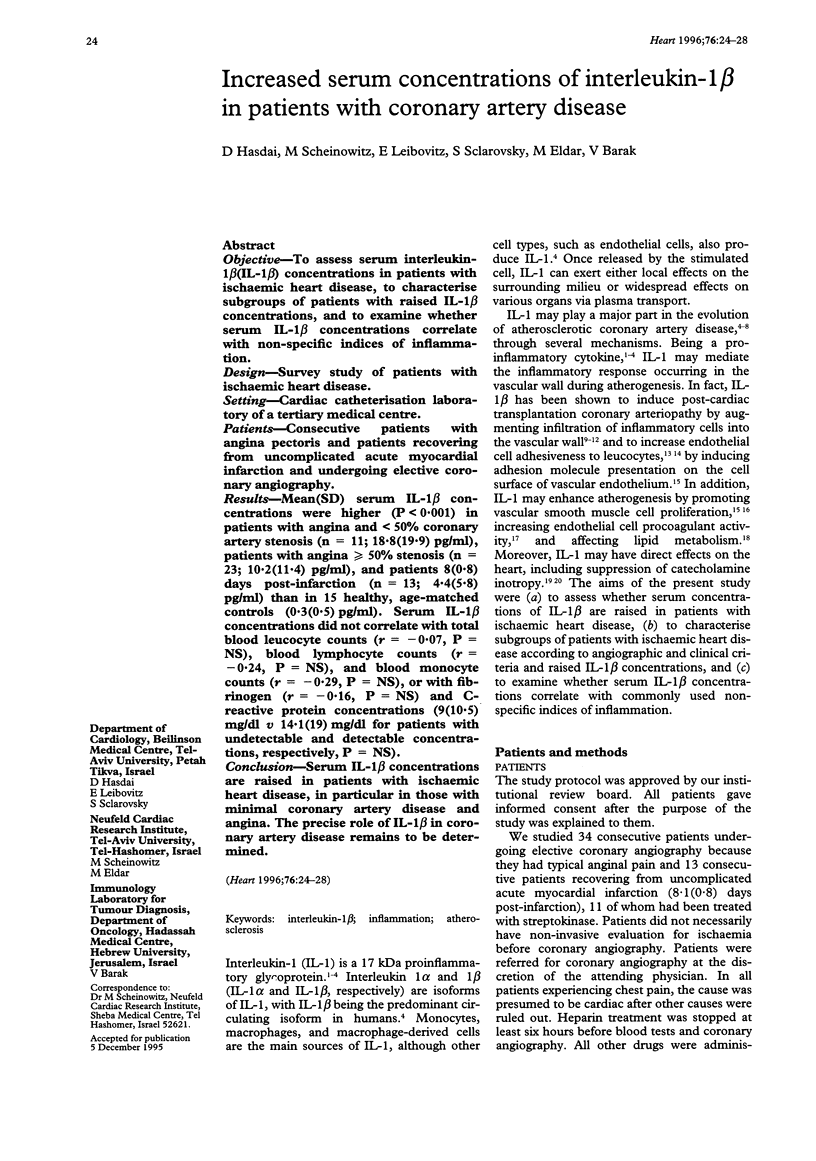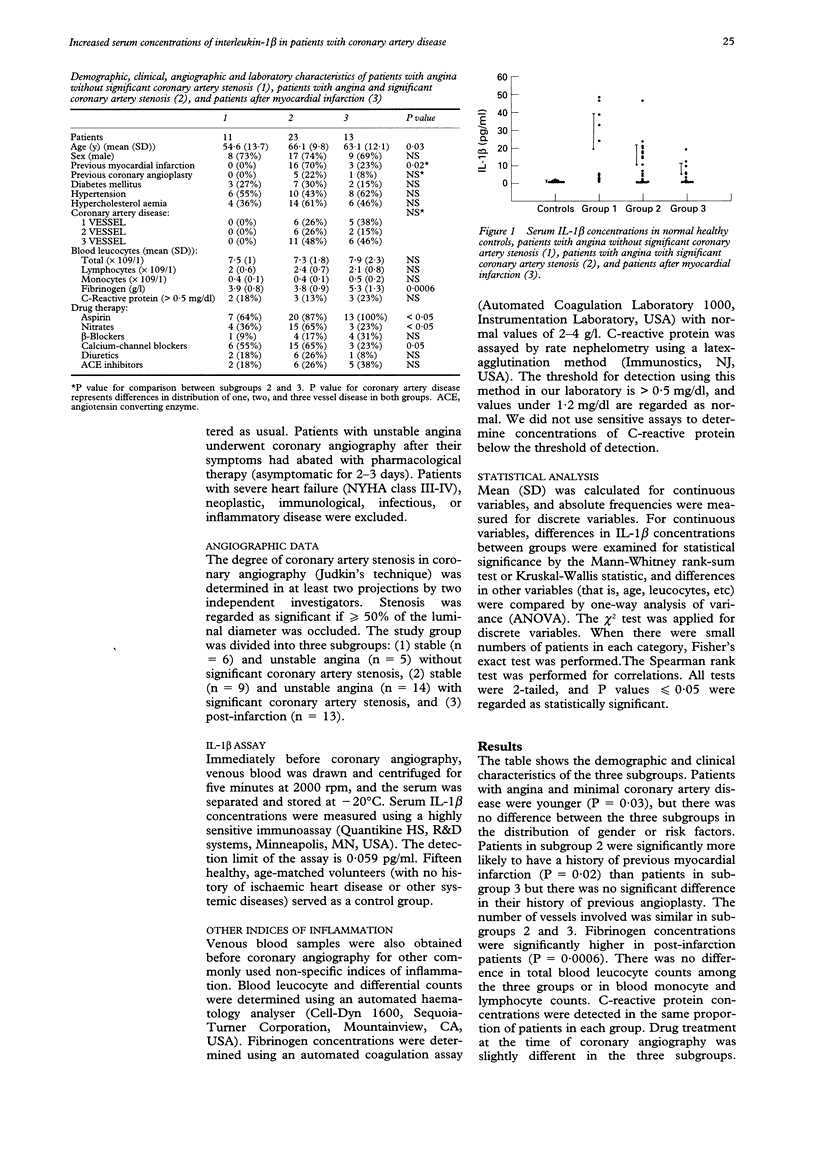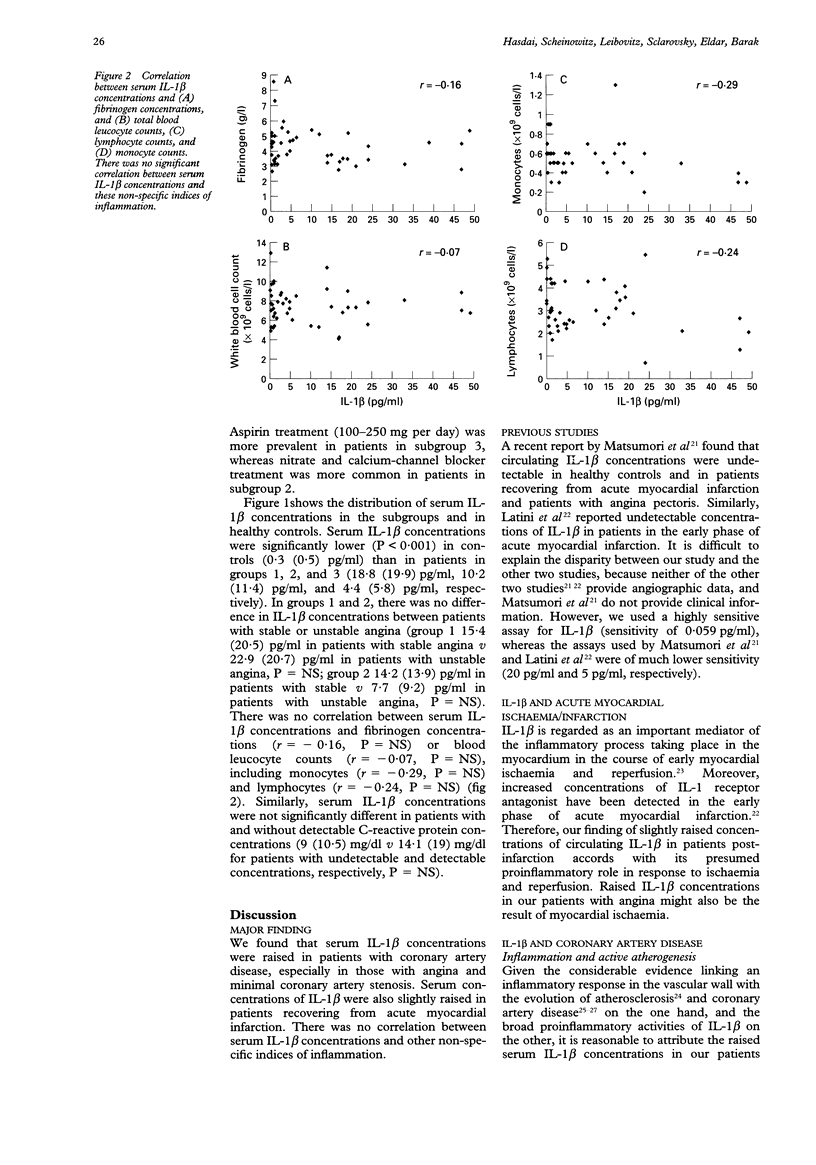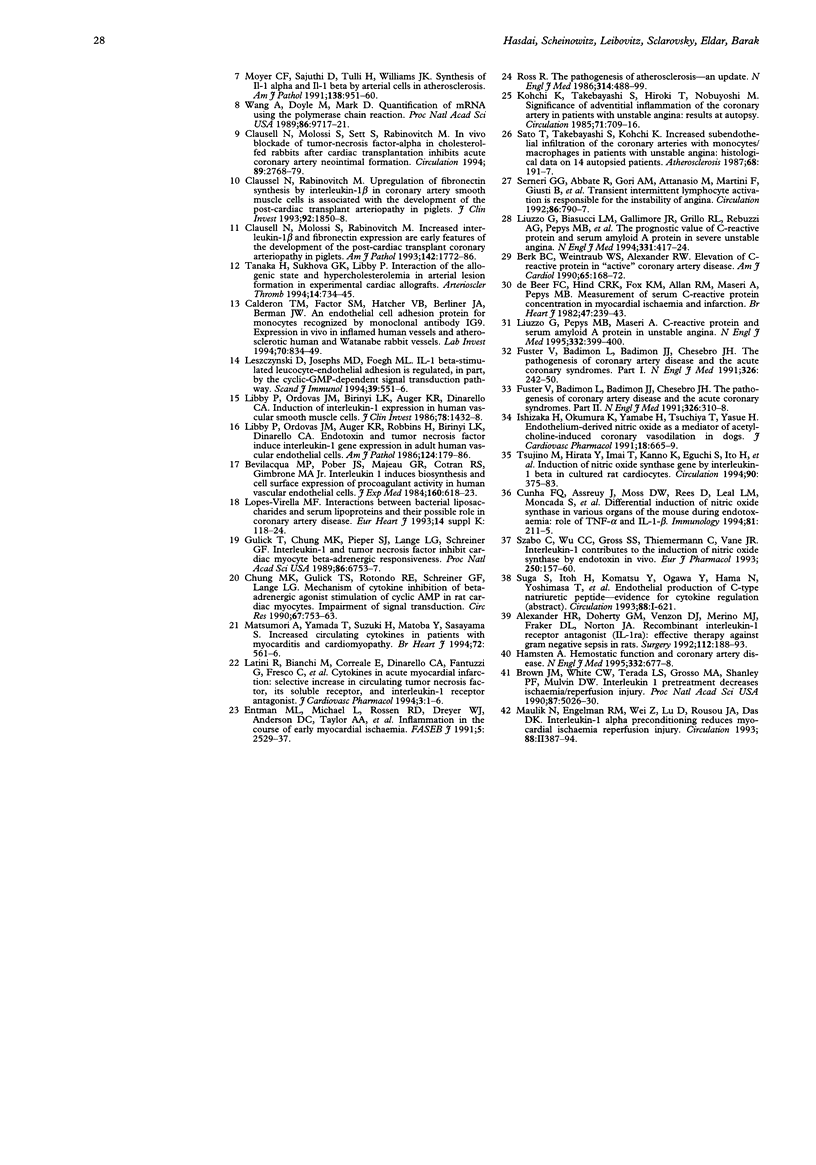Abstract
OBJECTIVE: To assess serum interleukin-1 beta (IL-1 beta) concentrations in patients with ischaemic heart disease, to characterise subgroups of patients with raised IL-1 beta concentrations, and to examine whether serum IL-1 beta concentrations correlate with non-specific indices of inflammation. DESIGN: Survey study of patients with ischaemic heart disease. SETTING: Cardiac catheterisation laboratory of a tertiary medical centre. PATIENTS: Consecutive patients with angina pectoris and patients recovering from uncomplicated acute myocardial infarction and undergoing elective coronary angiography. RESULTS: Mean(SD) serum IL-1 beta concentrations were higher (P < 0.001) in patients with angina and < 50% coronary artery stenosis (n = 11; 18.8(19.9) pg/ml), patients with angina > or = 50% stenosis (n = 23; 10.2(11.4) pg/ml), and patients 8(0.8) days post-infarction (n = 13; 4.4(5.8) pg/ml) than in 15 healthy, age-matched controls (0.3(0.5) pg/ml). Serum IL-1 beta concentrations did not correlate with total blood leucocyte counts (r = -0.07, P = NS), blood lymphocyte counts (r = -0.24, P = NS), and blood monocyte counts (r = -0.29, P = NS), or with fibrinogen (r = -0.16, P = NS) and C-reactive protein concentrations (9(10.5) mg/dl v 14.1(19) mg/dl for patients with undetectable and detectable concentrations, respectively, P = NS). CONCLUSION: Serum IL-1 beta concentrations are raised in patients with ischaemic heart disease, in particular in those with minimal coronary artery disease and angina. The precise role of IL-1 beta in coronary artery disease remains to be determined.
Full text
PDF




Selected References
These references are in PubMed. This may not be the complete list of references from this article.
- Alexander H. R., Doherty G. M., Venzon D. J., Merino M. J., Fraker D. L., Norton J. A. Recombinant interleukin-1 receptor antagonist (IL-1ra): effective therapy against gram-negative sepsis in rats. Surgery. 1992 Aug;112(2):188–194. [PubMed] [Google Scholar]
- Berk B. C., Weintraub W. S., Alexander R. W. Elevation of C-reactive protein in "active" coronary artery disease. Am J Cardiol. 1990 Jan 15;65(3):168–172. doi: 10.1016/0002-9149(90)90079-g. [DOI] [PubMed] [Google Scholar]
- Bevilacqua M. P., Pober J. S., Majeau G. R., Cotran R. S., Gimbrone M. A., Jr Interleukin 1 (IL-1) induces biosynthesis and cell surface expression of procoagulant activity in human vascular endothelial cells. J Exp Med. 1984 Aug 1;160(2):618–623. doi: 10.1084/jem.160.2.618. [DOI] [PMC free article] [PubMed] [Google Scholar]
- Brody J. I., Pickering N. J., Capuzzi D. M., Fink G. B., Can C. A., Gomez F. Interleukin-1 alpha as a factor in occlusive vascular disease. Am J Clin Pathol. 1992 Jan;97(1):8–13. doi: 10.1093/ajcp/97.1.8. [DOI] [PubMed] [Google Scholar]
- Brown J. M., White C. W., Terada L. S., Grosso M. A., Shanley P. F., Mulvin D. W., Banerjee A., Whitman G. J., Harken A. H., Repine J. E. Interleukin 1 pretreatment decreases ischemia/reperfusion injury. Proc Natl Acad Sci U S A. 1990 Jul;87(13):5026–5030. doi: 10.1073/pnas.87.13.5026. [DOI] [PMC free article] [PubMed] [Google Scholar]
- Chung M. K., Gulick T. S., Rotondo R. E., Schreiner G. F., Lange L. G. Mechanism of cytokine inhibition of beta-adrenergic agonist stimulation of cyclic AMP in rat cardiac myocytes. Impairment of signal transduction. Circ Res. 1990 Sep;67(3):753–763. doi: 10.1161/01.res.67.3.753. [DOI] [PubMed] [Google Scholar]
- Clausell N., Molossi S., Rabinovitch M. Increased interleukin-1 beta and fibronectin expression are early features of the development of the postcardiac transplant coronary arteriopathy in piglets. Am J Pathol. 1993 Jun;142(6):1772–1786. [PMC free article] [PubMed] [Google Scholar]
- Clausell N., Molossi S., Sett S., Rabinovitch M. In vivo blockade of tumor necrosis factor-alpha in cholesterol-fed rabbits after cardiac transplant inhibits acute coronary artery neointimal formation. Circulation. 1994 Jun;89(6):2768–2779. doi: 10.1161/01.cir.89.6.2768. [DOI] [PubMed] [Google Scholar]
- Clausell N., Rabinovitch M. Upregulation of fibronectin synthesis by interleukin-1 beta in coronary artery smooth muscle cells is associated with the development of the post-cardiac transplant arteriopathy in piglets. J Clin Invest. 1993 Oct;92(4):1850–1858. doi: 10.1172/JCI116776. [DOI] [PMC free article] [PubMed] [Google Scholar]
- Cunha F. Q., Assreuy J., Moss D. W., Rees D., Leal L. M., Moncada S., Carrier M., O'Donnell C. A., Liew F. Y. Differential induction of nitric oxide synthase in various organs of the mouse during endotoxaemia: role of TNF-alpha and IL-1-beta. Immunology. 1994 Feb;81(2):211–215. [PMC free article] [PubMed] [Google Scholar]
- Dinarello C. A. Interleukin-1. Rev Infect Dis. 1984 Jan-Feb;6(1):51–95. doi: 10.1093/clinids/6.1.51. [DOI] [PubMed] [Google Scholar]
- Dinarello C. A., Wolff S. M. The role of interleukin-1 in disease. N Engl J Med. 1993 Jan 14;328(2):106–113. doi: 10.1056/NEJM199301143280207. [DOI] [PubMed] [Google Scholar]
- Entman M. L., Michael L., Rossen R. D., Dreyer W. J., Anderson D. C., Taylor A. A., Smith C. W. Inflammation in the course of early myocardial ischemia. FASEB J. 1991 Aug;5(11):2529–2537. doi: 10.1096/fasebj.5.11.1868978. [DOI] [PubMed] [Google Scholar]
- Fuster V., Badimon L., Badimon J. J., Chesebro J. H. The pathogenesis of coronary artery disease and the acute coronary syndromes (1). N Engl J Med. 1992 Jan 23;326(4):242–250. doi: 10.1056/NEJM199201233260406. [DOI] [PubMed] [Google Scholar]
- Fuster V., Badimon L., Badimon J. J., Chesebro J. H. The pathogenesis of coronary artery disease and the acute coronary syndromes (2). N Engl J Med. 1992 Jan 30;326(5):310–318. doi: 10.1056/NEJM199201303260506. [DOI] [PubMed] [Google Scholar]
- Gearing A. J., Johnstone A. P., Thorpe R. Production and assay of the interleukins. J Immunol Methods. 1985 Oct 24;83(1):1–27. doi: 10.1016/0022-1759(85)90053-5. [DOI] [PubMed] [Google Scholar]
- Gulick T., Chung M. K., Pieper S. J., Lange L. G., Schreiner G. F. Interleukin 1 and tumor necrosis factor inhibit cardiac myocyte beta-adrenergic responsiveness. Proc Natl Acad Sci U S A. 1989 Sep;86(17):6753–6757. doi: 10.1073/pnas.86.17.6753. [DOI] [PMC free article] [PubMed] [Google Scholar]
- Hamsten A. Hemostatic function and coronary artery disease. N Engl J Med. 1995 Mar 9;332(10):677–678. doi: 10.1056/NEJM199503093321011. [DOI] [PubMed] [Google Scholar]
- Kohchi K., Takebayashi S., Hiroki T., Nobuyoshi M. Significance of adventitial inflammation of the coronary artery in patients with unstable angina: results at autopsy. Circulation. 1985 Apr;71(4):709–716. doi: 10.1161/01.cir.71.4.709. [DOI] [PubMed] [Google Scholar]
- Latini R., Bianchi M., Correale E., Dinarello C. A., Fantuzzi G., Fresco C., Maggioni A. P., Mengozzi M., Romano S., Shapiro L. Cytokines in acute myocardial infarction: selective increase in circulating tumor necrosis factor, its soluble receptor, and interleukin-1 receptor antagonist. J Cardiovasc Pharmacol. 1994 Jan;23(1):1–6. [PubMed] [Google Scholar]
- Leszczynski D., Josephs M. D., Foegh M. L. IL-1 beta-stimulated leucocyte-endothelial adhesion is regulated, in part, by the cyclic-GMP-dependent signal transduction pathway. Scand J Immunol. 1994 Jun;39(6):551–556. doi: 10.1111/j.1365-3083.1994.tb03412.x. [DOI] [PubMed] [Google Scholar]
- Libby P., Ordovas J. M., Auger K. R., Robbins A. H., Birinyi L. K., Dinarello C. A. Endotoxin and tumor necrosis factor induce interleukin-1 gene expression in adult human vascular endothelial cells. Am J Pathol. 1986 Aug;124(2):179–185. [PMC free article] [PubMed] [Google Scholar]
- Libby P., Ordovas J. M., Birinyi L. K., Auger K. R., Dinarello C. A. Inducible interleukin-1 gene expression in human vascular smooth muscle cells. J Clin Invest. 1986 Dec;78(6):1432–1438. doi: 10.1172/JCI112732. [DOI] [PMC free article] [PubMed] [Google Scholar]
- Libby P., Schwartz D., Brogi E., Tanaka H., Clinton S. K. A cascade model for restenosis. A special case of atherosclerosis progression. Circulation. 1992 Dec;86(6 Suppl):III47–III52. [PubMed] [Google Scholar]
- Liuzzo G., Biasucci L. M., Gallimore J. R., Grillo R. L., Rebuzzi A. G., Pepys M. B., Maseri A. The prognostic value of C-reactive protein and serum amyloid a protein in severe unstable angina. N Engl J Med. 1994 Aug 18;331(7):417–424. doi: 10.1056/NEJM199408183310701. [DOI] [PubMed] [Google Scholar]
- Lopes-Virella M. F. Interactions between bacterial lipopolysaccharides and serum lipoproteins and their possible role in coronary heart disease. Eur Heart J. 1993 Dec;14 (Suppl K):118–124. [PubMed] [Google Scholar]
- Matsumori A., Yamada T., Suzuki H., Matoba Y., Sasayama S. Increased circulating cytokines in patients with myocarditis and cardiomyopathy. Br Heart J. 1994 Dec;72(6):561–566. doi: 10.1136/hrt.72.6.561. [DOI] [PMC free article] [PubMed] [Google Scholar]
- Maulik N., Engelman R. M., Wei Z., Lu D., Rousou J. A., Das D. K. Interleukin-1 alpha preconditioning reduces myocardial ischemia reperfusion injury. Circulation. 1993 Nov;88(5 Pt 2):II387–II394. [PubMed] [Google Scholar]
- Meager A., Leung H., Woolley J. Assays for tumour necrosis factor and related cytokines. J Immunol Methods. 1989 Jan 6;116(1):1–17. doi: 10.1016/0022-1759(89)90306-2. [DOI] [PubMed] [Google Scholar]
- Moyer C. F., Sajuthi D., Tulli H., Williams J. K. Synthesis of IL-1 alpha and IL-1 beta by arterial cells in atherosclerosis. Am J Pathol. 1991 Apr;138(4):951–960. [PMC free article] [PubMed] [Google Scholar]
- Oltrona L., Merlini P. A., Pezzano A. C-reactive protein and serum amyloid A protein in unstable angina. N Engl J Med. 1995 Feb 9;332(6):399–400. [PubMed] [Google Scholar]
- Ross R. The pathogenesis of atherosclerosis--an update. N Engl J Med. 1986 Feb 20;314(8):488–500. doi: 10.1056/NEJM198602203140806. [DOI] [PubMed] [Google Scholar]
- Sato T., Takebayashi S., Kohchi K. Increased subendothelial infiltration of the coronary arteries with monocytes/macrophages in patients with unstable angina. Histological data on 14 autopsied patients. Atherosclerosis. 1987 Dec;68(3):191–197. doi: 10.1016/0021-9150(87)90198-5. [DOI] [PubMed] [Google Scholar]
- Serneri G. G., Abbate R., Gori A. M., Attanasio M., Martini F., Giusti B., Dabizzi P., Poggesi L., Modesti P. A., Trotta F. Transient intermittent lymphocyte activation is responsible for the instability of angina. Circulation. 1992 Sep;86(3):790–797. doi: 10.1161/01.cir.86.3.790. [DOI] [PubMed] [Google Scholar]
- Szabó C., Wu C. C., Gross S. S., Thiemermann C., Vane J. R. Interleukin-1 contributes to the induction of nitric oxide synthase by endotoxin in vivo. Eur J Pharmacol. 1993 Nov 30;250(1):157–160. doi: 10.1016/0014-2999(93)90634-t. [DOI] [PubMed] [Google Scholar]
- Tanaka H., Sukhova G. K., Libby P. Interaction of the allogeneic state and hypercholesterolemia in arterial lesion formation in experimental cardiac allografts. Arterioscler Thromb. 1994 May;14(5):734–745. doi: 10.1161/01.atv.14.5.734. [DOI] [PubMed] [Google Scholar]
- Tsujino M., Hirata Y., Imai T., Kanno K., Eguchi S., Ito H., Marumo F. Induction of nitric oxide synthase gene by interleukin-1 beta in cultured rat cardiocytes. Circulation. 1994 Jul;90(1):375–383. doi: 10.1161/01.cir.90.1.375. [DOI] [PubMed] [Google Scholar]
- Wang A. M., Doyle M. V., Mark D. F. Quantitation of mRNA by the polymerase chain reaction. Proc Natl Acad Sci U S A. 1989 Dec;86(24):9717–9721. doi: 10.1073/pnas.86.24.9717. [DOI] [PMC free article] [PubMed] [Google Scholar]
- de Beer F. C., Hind C. R., Fox K. M., Allan R. M., Maseri A., Pepys M. B. Measurement of serum C-reactive protein concentration in myocardial ischaemia and infarction. Br Heart J. 1982 Mar;47(3):239–243. doi: 10.1136/hrt.47.3.239. [DOI] [PMC free article] [PubMed] [Google Scholar]


